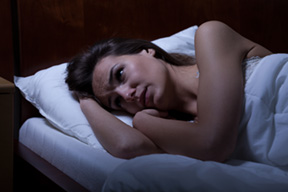Why it can be so hard to get a good night’s sleep…and why it matters
 People have been sleeping, not sleeping, and chronicling their sleep (or lack thereof) throughout recorded history. In 450 BC, the Greek physician Alcmaeon produced the earliest documented theory of sleep, which he described as a loss of consciousness as blood retreats from the surface of the body. Fifty years later, Hippocrates theorized that sleep was due to blood retreating to the inner regions of the body. Still fifty years after Hippocrates, Aristotle saw sleep as caused by warm vapors rising from the heart during digestion, and concluded that sleep is a time of physical renewal. It was nearly another 200 years before Galen established that consciousness resides in the brain, not the heart.
People have been sleeping, not sleeping, and chronicling their sleep (or lack thereof) throughout recorded history. In 450 BC, the Greek physician Alcmaeon produced the earliest documented theory of sleep, which he described as a loss of consciousness as blood retreats from the surface of the body. Fifty years later, Hippocrates theorized that sleep was due to blood retreating to the inner regions of the body. Still fifty years after Hippocrates, Aristotle saw sleep as caused by warm vapors rising from the heart during digestion, and concluded that sleep is a time of physical renewal. It was nearly another 200 years before Galen established that consciousness resides in the brain, not the heart.
“I couldn’t sleep at all last night…”
– Bobby Lewis, “Tossin’ and Turnin’”
What we know of early sleep medicine comes from the Edwin Smith, Ebers and Kahun papyri. These documents refer to Egyptian remedies for insomnia, which consisted of poppy seeds out of which the then current recipe for opium was prescribed.
What these early healers didn’t know, however, was that many cases didn’t require medication at all. Instead, those early Egyptians were experiencing paradoxical insomnia, that is, complaining they weren’t sleeping when in fact, they were. In fact, the most common cause of most insomnia is psychological: it can be related to some underlying anxiety, a stressful life event like divorce, death or trauma – sufferers develop poor sleep hygiene and eventually become chronic insomniacs.
Those early healers had no way to diagnose narcolepsy until 1888, when it was identified by Gelineau. Similarly, they had no name for restless legs syndrome, which was described in 1945 by Ekborn.
“How blessed are some people … to whom sleep is a blessing that comes nightly.”
– Bram Stoker, Dracula
 The modern approach to sleep disorders research began in 1913 with the publication of Le problem physiologique du sommeil, the first text to examine sleep from a physiological perspective. Dr. Nathaniel Kleitman, known as the Father of American sleep research, began questioning the regulation of sleep and wakefulness and of circadian rhythms in the 1920s. In 1953, he and Dr. Eugene Aserinsky made the landmark discovery of rapid eye movement (REM) during sleep.
The modern approach to sleep disorders research began in 1913 with the publication of Le problem physiologique du sommeil, the first text to examine sleep from a physiological perspective. Dr. Nathaniel Kleitman, known as the Father of American sleep research, began questioning the regulation of sleep and wakefulness and of circadian rhythms in the 1920s. In 1953, he and Dr. Eugene Aserinsky made the landmark discovery of rapid eye movement (REM) during sleep.
Three years later, Aaron Lerner named the sleep disorder that is experienced by more than 18 million Americans today. Obstructive sleep apnea can cause fragmented sleep and low blood oxygen levels.
One of the most common signs of obstructive sleep apnea is loud and chronic snoring, but snoring is the least of these poor sleepers’ problems. Obstructive sleep apnea is linked to car crashes, high blood pressure, diabetes, stroke and heart disease. And there is increasing literature that demonstrates that treating sleep apnea accrues benefits in all sorts of different areas, whether lowering incidences of automobile crashes, lowering blood pressure, protecting the cardiovascular system.
In addition, according to the New York University Medical Center website, a 2015 study found “a troubling link between abnormal breathing patterns like snoring and brain function.” They studied the medical histories of more than twenty-four hundred people between the ages of 55 and 90. They found that those who snored or who had sleep apnea were diagnosed with mild cognitive impairment at an average age of 77. For those without sleep-related breathing problems, cognitive problems didn’t appear until an average age of 90.
And, the researchers found, those with breathing problems during sleep were also more likely to suffer from Alzheimer’s disease at an earlier age. For snorers, the Alzheimer’s diagnosis came at an average age of 83. For those without breathing problems, the average age for Alzheimer’s onset was 88.
“Leave me where I am; I’m only sleeping.”
– Lennon-McCartney, “I’m only sleeping.”
In dreaming sleep, with the exception of eye muscles and the diaphragm, the body is intended to be paralyzed. In REM sleep behavior disorder, an interesting condition predominantly seen in older men, sleepers will act out their dreams, often those with violent content. They lose the normal paralysis that is supposed to be present in dreaming sleep. A typical example: the patient dreams he is being chased by a bear, and he “reacts” by punching the bear in the snout. Unfortunately, it’s his wife who receives the blow. And while some defendants in criminal cases have used the “REM sleep behavior disorder defense,” few have done so successfully.
“I don’t sleep at night. The doctor can’t tell why. He’s a clever fellow, or I shouldn’t have him, but I get nothing out of him but bills.”
– John Galsworthy, The Forsyte Saga
Fortunately, the science of sleep medicine has grown far beyond the understanding of Galsworthy’s luckless physician. With backgrounds in psychiatry, neurology, neurophysiology, and pulmonology, as well as Board certifications in sleep medicine, the three physicians featured on our cover – Dr. Soham Sheth, Dr. Patrick Harding, and Dr. Robert Vorona – have the most current and reliable knowledge of the mysteries of sleep and its disorders, and many more options to help their patients achieve what Shakespeare referred to as “Sleep that knits up the ravell’d sleave of care … chief nourisher in life’s feast.”
“Even a soul submerged in sleep is hard at work and helps make something of the world.”
– Heraclitus, “Fragments”
The body is far from inactive during sleep. In the deepest and most restorative stage of sleep, the blood pressure drops, breathing is slower, muscles are relaxed and blood supply to the muscles increases – and importantly, it’s when tissue growth and repair occurs. It’s vital for the restoration of brain function. It is, as one of our doctor honorees says, “when the trash is taken out, when the body has maximal benefit in terms of recovery.”

